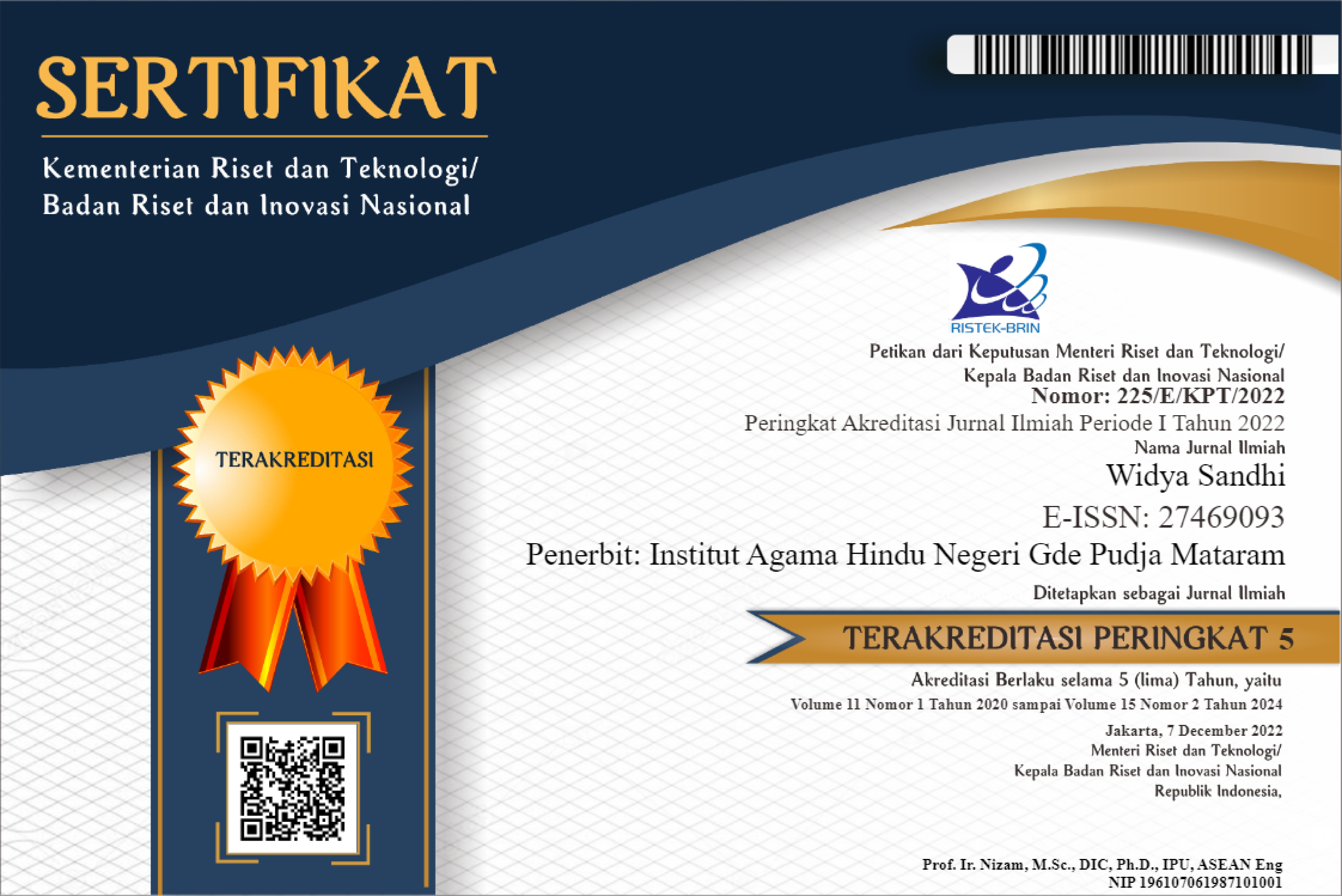PURA TAMAN LINGSAR, DALAM MEMBANGUN KOHESI SOSIAL ANTARA ISLAM WETU TELU ETNIS SASAK DENGAN KOMUNITAS HINDU ETNIS BALI DI LOMBOK
Abstract
The Indonesian nation, also dubbed the Pluralistic nation, because various major religions exist in Indonesia such as: Islam, Protestant Christianity, Catholic Christianity, Hinduism, Buddhism and Kong Hut Chu as well as the Original Archipelago religion still survive. Referring to this phenomenon, this seems to underlie the founders of the Indonesian nation to formulate the Pancasila and the 1945 Constitution as the State of the Republic of Indonesia. As a nation that has diversity, with a variety of ethnicities, religions, cultures, and customs, besides being an attraction due to its uniqueness and specificity, distinguish it from other nations in the World. Strengthening politics Identity is expressed through various forms of representation that are recognized by others and themselves. This condition holds the seeds of conflict quite high and easily ridden by other interests that are contrary to the life of the nation and state under the ideology of Pancasila and the 1945 Constitution. These problems can only be anticipated through increased fostering of harmony, and instilling awareness of the diversity of the nation and a country that is always carried out by all components of the Indonesian nation. On the island of Lombok there is a monumental symbol of the size and harmony of life between religious communities, namely between the Balinese Hindu Community and the Sasak Wetu Telu Islamic Community. The monument is Pura Lingsar, which until now still exists to function as a medium to increase social and religious social interaction of both ethnicities and religions on Lombok Island.
References
Agung, A.A. Ketut. 1991. Kupu-Kupu Kuning yang Nyeberang di Selat Lombok, Denpasar : Upada Sastra.
Ahyar Fadly, M. 2008. Islam Lokal, Akulturasi Islam di Bumi Sasak, Pringgarata, Lombok Tengah, Nusa Tenggara Barat : STAIIQH Press.
Ali, Murzid. 2000. Problema Komunikasi Antar Umat Beragama,Jakarta : Badan Penelitian dan pengambangan Agama Departemen Agama RI, Proyek peningkatan Kerukunan Hindup Umat Beragama Jakarta.
Ali, M. Muhammad. 1999. Praktik Keberagamaan Islam Watu Telu di Lombok Nusa Tenggara Barat, Tesis Program Pascasarjana Universitas Muham-madiyah Jakarta.
Bryan S. Turner, 2012. Teori Sosial dari Klasik sampai Postmodern, Yogyakarta : Pustaka Pelajar.
Budiwanti, Erni. 2000 Islam Sasak, Wetu Telu Versus Waktu Lima, Yogyakarta : LkiS (Yayasan Adikarya IKAPI dan Ford Foundation).
Fadly, Muhammad Ahyar. 2008. Islam Lokal, Akulturasi Islam di Bumi Sasak, Nusa Tenggara Barat : STAIIQH Press.
Lalu Lukman, H. 2005. Pulau Lombok dalam Sejarh, ditinjau dari aspek Budaya, Koleksi Perpustakaaan Daerah Nusa Tenggara Barat.
Parekh, Bhikhu, 2008. Rithinking Multikulturalisme, Keberagaman Budaya dan Teori Politik, Yogyakarta : Kanisius.
P. Huntington, Samuel, 2001. Benturan antar Peradaban dan Masa depan Politiik Dunia Yogyakarta : Qalam.
Raba, Manggaukang dan Asmawati, 2002. Fakta-Fakta tentang Lombok dan Sumbawa, Nusa Tenggara Barat, Mataram : Koleksi Pemerintah Nusa tenggara Barat.
Raho Bernard. 2007. TeoriSosiologi Modern. Jakarta: PustakaPrestasi.
Reede, J.J. de, 1989. Universal Symbolism, dalam Simbolism in Hinduism, Central Chinmaya Mission Trust Bombay.
Richard King, 2001. Agama, Orientalisme dan Poskolonialisme, Sebuah kajian tentang Pertelingkahan antara Rasionalitas dan Mistik, Yogyakarta : Qalam.
Ritzer, George. 2012. Teori Sosiologi dari sosiologi Klasik sampai Perkembangan terakhir Postmodern, Yogyakarta : Pustaka Pelajar.
Sastrodiwiryo, Soegianto. Perjalanan Dang Hyang Nirartha, sebuah Dharmayatra (1478-1560) dari Daha sampai Tambora, Denpasar : PT BP.
Sugriwa, I.G.B. 1991. Dwijendra Tattwa, Denpasar : Upada Sastra.
Suhadi HP, Dkk. H. Usri Indah Handayani. 2004. Peninggalan Sejarah dan Kepurbakalaan Nusa Tenggara Barat, Pemerintah Propinsi Nusa Tenggara Barat, Dinas Kebudayaan dan Pariwisata, Musium Negeri Propinsi Nusa Tenggara Barat.
Sujangi, 1991/1992. Kajian Agama dan Masyarakat, 15 tahun Badan Penelitian dan Pengembangan Agama, 1975-1990, Jakarta : Badan Penelitian dan Pengembangan Agama, Departemen Agama RI.
Sunoto, 1982. Mengenal Filsafat Pancasila, Pendekatan Melalui Metafisika Logika, Etika Seri Pertama, Yogyakarta : Fakultas Ekonomi Universitas Islam Indonesia.
Tim. 1997. Bingkai Tiologi Kerukunan Umat Beragama di Indonesia, Jakarta : Badan Penelitian dan pengambangan Agama Departemen Agama RI, Proyek peningkatan Kerukunan Hindup Umat Beragama Jakarta.
Tim, Kerja MPR. 2012. Empat Pilar Kehidupan Berbangsa dan Bernegara, Jakarta : Sekretariat Jenderal MPR RI, Periode 2009 – 20114.
Tim, Redaksi Seri Dian II Tahun I, 1994. Dialog : Kritik dan Identitas Agama, Yogyakarta : bekerjasama dengan Pustaka Pelajar.
Tim, Redaksi Seri Dian II Tahun I, 1994. Spiritualitas Baru : Agama dan Aspirasi Rakyat, Yogyakarta : bekerjasama dengan Pustaka Pelajar.
Tim, Depdikbud. 1988. Sejarah Daerah Nusa Tenggara Barat (NTB), Proyek Pelestarian/Pemanfaatan Peninggalan Sejarah dan Purbakala Nusa Tenggara Barat.
Titib, I Made.2003. Teologi & Simbol-Simbol Dalam Agama Hindu, Surabaya : Paramita.
Toha, Anis Malik. 2005. Tren Pluralisme Agama : Tinjauan Kritis, Jakarta : Perspektif.
Wirawan, I Wayan Ardhi, 2010. Reproduksi Identitas dan Pencitraan Mahagotra Pasek Sanak Sapta Rsi Pada Komunitas Hindu di Kota Mataram, Nusa Tenggara Barat, Disertasi Program Doktoral Universitas Udayana.
Zailani, Kamarudin. 2007. Satu Agama Banyak Tuhan, Melacak Akar Sejarah Teologi Wetu Telu, Mataram : Pantheon Media Pressindo.
http://en.wikipedia.org/wiki/Dominus-Iesus. diunduh pada 26 Juni 2017).
(http://www. hidayatullah. com/read/18236/29/07/2011/ pluralisme,- klaim- kebenaran- yang-berbahaya.html diunduh pada 26Juni 2017).
(http://www. mongabay. co.id /2015/05/09/- berapa-jumlah-pulau-yang-dimiliki-indo-nesia-sebenarnya/diunduh 26 Juni 2017).

This work is licensed under a Creative Commons Attribution-NonCommercial-ShareAlike 4.0 International License.
Authors who publish with this journal agree to the following terms:
- Authors retain copyright and grant the journal right of first publication with the work simultaneously licensed under a Creative Commons Attribution-ShareAlike 4.0 International License. that allows others to share the work with an acknowledgment of the work's authorship and initial publication in this journal.
- Authors are able to enter into separate, additional contractual arrangements for the non-exclusive distribution of the journal's published version of the work (e.g., post it to an institutional repository or publish it in a book), with an acknowledgment of its initial publication in this journal.
- Authors are permitted and encouraged to post their work online (e.g., in institutional repositories or on their website) prior to and during the submission process, as it can lead to productive exchanges, as well as earlier and greater citation of published work (See The Effect of Open Access).






.jpg)




